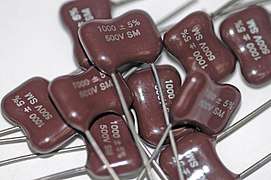Silver mica capacitor
Silver mica capacitors are high precision, stable and reliable capacitors. They are available in small values, and are mostly used at high frequencies and in cases where low losses (high Q) and low capacitor change over the time is desired.
History
Cornell Dubilier Electronics was the inventor of the mica capacitor. RF mica capacitors feature high Q performance without the cracking associated with ceramic and porcelain capacitors. They are still used in military, aerospace, medical and audio applications.[1]
Types
There are 2 distinct types of mica capacitor.
Clamped Mica capacitors
Now obsolete, these were in use in the early 20th century. They consisted of sheets of mica and copper foil sandwiched together and clamped. These had even worse tolerance and stability than other clamped capacitors since the mica surface is not perfectly flat and smooth. References to mica capacitors from the 1920s always refers to this type.
Silver Mica capacitors
Commonly known as silver mica capacitors, these rendered clamped mica capacitors obsolete. Instead of being clamped with foils these are assembled from sheets of mica coated on both sides with deposited metal. The assembly is dipped in epoxy. The advantages are:
- Greater stability, since there are no capacitive airgaps that can change dimension.
- Airtight enclosure removes the risk of oxidation or corrosion of plates or connections.
- Greater capacitance per volume, since there are no airgaps between plates and mica, the conducting surfaces can be thinner.
- No clamping mechanism is needed.
They are sometimes informally referred to as mica capacitors. Any modern reference to mica capacitors can be assumed to mean these, unless pre-war equipment is being discussed. Even though these capacitors are extremely useful, Silver mica capacitors are less commonly used today due to bulkiness and high cost. There is a high level of compositional variation in the raw material leading to higher costs in relation to inspection and sorting. They are getting closer to obsolescence as advances are made in ceramic and porcelain materials.
Silver mica capacitors are still indispensable in some custom applications. Circuit designers still turn to mica capacitors for high-power applications such as RF transmitters and electric instruments and amplifiers because cheaper ceramic and porcelain capacitors can't withstand heat as well. Silver mica remains widely used in high-voltage applications, due to mica’s high breakdown voltage. Silver Mica capacitors are used at 100 V to 10 kV, ranging from a few pF up to a few nF, and the average temperature coefficient is around 50 ppm/°C.[2]
Silver mica capacitors in electric instruments
The silver mica capacitor is a suitable choice of capacitor to be soldered across pins 2 & 3 of the volume potentiometer in some electric guitars to prevent an effect known (in musician's terminology) as "treble bleed (loss) when the volume is lowered". Although practically any type of capacitor may be used with equal effect, the silver mica type is considered more attractive in this application. Higher frequencies pass through and bypass the volume potentiometer, the overall effect (described in musician's terminology) being "providing very little tonal coloration and clear harmonics". Capacitor values such as 180pF and 280pF are often used.[3]
See also
References
- "MICA CAPACITORS". cde.com.
- "Mica Capacitor". capacitorguide.com.
- "Silver Mica Capacitor, epoxy dipped 500V". reverb.com.
